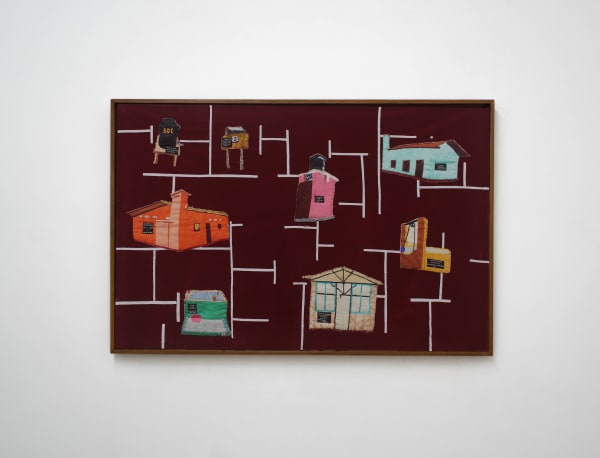FAMILIES 'NOT' IN THE LIST: Hema Shironi
In the absence of permanent structures, home is contained in the memories and bonds shared between people and communities. Hema Shironi’s Families ‘Not’ In the List is an ongoing inquiry that moves between memory and identity as she tries to find what meaning the home holds outside of its physical structure. The series arises from the frequent relocations of the artist’s family, which have been intertwined with socio-political developments in Sri Lanka since the early 90s. Hema Shironi employs the practice of needlework to thread through and across her reflections, recounting the many journeys, cultures and experiences that she assimilated as she moved from one place to another. Passed down along the matrilineal line, from mother to daughter, needlework brings permanence and continuity.
The medium’s association with domesticity is employed to pay homage to three generations of women in Latha Mandapaya. In an expression of admiration, Shironi adapts an ancient pillared structure to essay her family’s resilience despite all odds. The use of patterned fabric, with its unique textures and designs, recalls the different geographies traversed by these women over the years.
The close bond she has shared with her grandmother is recounted in 199 Miles Away, where she fondly recalls her travel through houses that move along wheels, like the trains that they would take across the country. Home is sought in these familial bonds and memories. In Jewels of Forgotten Memories, old jewellery boxes which once housed family heirlooms are repurposed to encase fond memories of childhood. The nimble-size of the photographs are, gently punctured to trace the solid outline of homes, expressing a frailty when held in one’s hand.
Shironi recurrently uses grided structures and embroidered foundations to mediate conversations on the structural aspects of a house. In works such as, A Family Photo of Her Husband and Children, family portraits come across as an outline of the self. Sewn on green mesh that bears resemblance to structures used in construction, the portraits are inspired from photographs taken against the backdrop of houses constructed under welfare schemes. The work identifies the way in which developmental projects initiated with good intentions, more often than not fail to meet the immediate needs of communities. The artist also observes the way in which these projects enforce uniformity for the sake of convenience, diminishing the identity of the individual within these vibrant and eclectic communities.
This concern is further explored in Up in the Air and Down where a brightly coloured playground exists against the emptiness of the quilt. The distant tombstones further underscore the lifelessness; as the artist speaks of the absence of children to occupy these parks. The artwork responds to the phenomenon of new parks that have come up in localities where neither the children nor their families can make time for recreational activities.
The soft quality of blankets in these works evokes tender memories of childhood. While the same quality of comfort is juxtaposed with incisive political commentary. In Lion is called the ‘King of the Jungle’, the artist exchanges the colours of the Sri Lankan flag to create alternate arrangements, and in the process flips how different ethnic and religious minorities are represented on the national flag. Although imbued with a childlike playfulness, it offers a political reimagination that aspires for communal harmony in the distant future.
Shironi weaves through tender memories to build a narrative of home and community that transcends developmental agendas and geographic boundaries. The artist challenges conventional notions of belonging, with a focus on kinship built through shared experience. Families ‘Not’ In the List is a testament to the strength of these bonds, highlighting the way in which they root us, regardless of where we find ourselves.









